As an Amazon Associate KitchenwareSets.com earns from qualifying purchases.
Flawless Kitchen Tile Floor Next To Hardwood Transitions
That moment in a kitchen remodel when you have to decide how your beautiful new tile floor will meet the existing hardwood in the rest of your home can be surprisingly stressful. Will it look awkward? Will it create a weird bump in the floor? An improperly planned transition can ruin the flow of your entire living space, creating a visual disconnect that feels cheap or, even worse, a tripping hazard for you and your family.
The challenge lies in bridging two different materials, often with different heights and textures, without it looking like an afterthought. You want a connection that feels intentional, stylish, and seamless, elevating your home’s design instead of detracting from it. It’s a detail that, when done right, makes a world of difference in the professional finish of your home renovation.
A flawless transition between kitchen tile and hardwood is crucial for both safety and style. It involves using materials like T-molding, creative tile layouts, or inlays to bridge the gap, protect the vulnerable edges of both flooring types, and create a visually cohesive and beautiful flow between your different living spaces. This guide, curated from expert interior designer advice and successful real-world projects, will show you exactly how to achieve a designer-level result.
Awkward Floor Change? Here’s How to Flawlessly Transition Kitchen Tile to Hardwood in 2025
A flawless transition between kitchen tile and hardwood is crucial for both safety and style. It involves using materials like T-molding, creative tile layouts, or inlays to bridge the gap, protect floor edges, and create a visually cohesive flow between different living spaces.
Why a Perfect Floor Transition Matters More Than You Think
A well-executed floor transition serves three key purposes: it prevents tripping hazards caused by height differences, protects the vulnerable edges of both the tile and hardwood from damage, and creates a seamless aesthetic flow that enhances the overall design of your home. It’s a detail that merges functionality with design to create a polished and safe environment.
- Safety First: Even a small difference in floor height can create a dangerous trip hazard. A proper transition piece, like a reducer, creates a smooth and gentle ramp, ensuring safety for everyone in the home. This is especially important for households with children or elderly residents and is often guided by building codes.
- Durability and Protection: The edges of both tile and hardwood planks are vulnerable to chipping, cracking, and splintering from foot traffic and cleaning. A transition strip covers these raw edges, protecting your investment and keeping your floors looking pristine for years to come.
- Aesthetics and Flow: A deliberate, well-chosen transition acts as a visual bridge between two distinct spaces. It makes the design feel cohesive and intentional rather than disjointed. In an open floor plan, a beautiful transition can become a design feature in its own right, enhancing the overall property value.
11 Stunning Kitchen Tile to Wood Floor Transition Ideas for a Designer Look
From timeless classics that offer a clean and simple solution to bold, custom designs that become the focal point of a room, there is a perfect transition for every home style and skill level. These ideas are selected for their popularity in high-end design magazines and their real-world applicability, ensuring you can find a stunning and practical solution for your space.
1. The Timeless Classic: Straight Line Transition
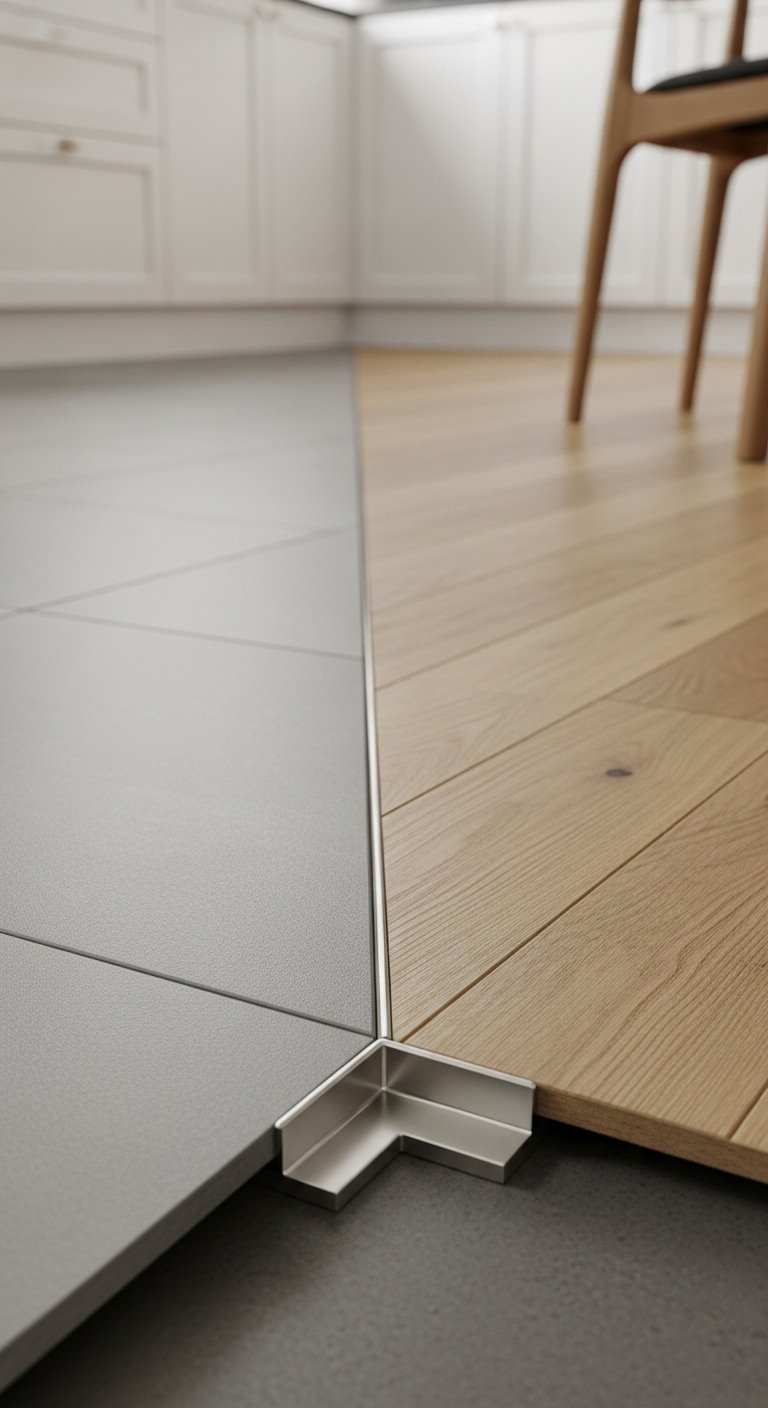
Save this clean and modern idea to your ‘Minimalist Home’ board!
This method uses a T-molding strip to cleanly cover the expansion gap between two level floors, creating a crisp and intentional line. It is the most straightforward and popular approach for a reason: it’s clean, effective, and works with nearly any design style.
- Materials Needed: T-molding transition strip, measuring tape, miter saw or tipssaw, construction adhesive, rubber mallet.
- Step-by-Step Directions:
- Ensure both the tile and hardwood floors are installed, leaving a consistent expansion gap (typically 1/2 to 3/4 inch) between them.
- Measure the length of the transition space accurately.
- Cut the T-molding strip to the measured length using a miter saw for wood or a tipssaw for metal.
- Apply a bead of construction adhesive into the gap.
- Press the “T” part of the molding firmly into the gap. Use a rubber mallet and a scrap piece of wood to gently tap it into place until it’s snug and level.
> Pro-Tip: Always buy a transition strip slightly longer than you need. This gives you room for error and ensures you can make a perfect cut without coming up short.
2. The Designer’s Choice: Geometric Hexagon Flow
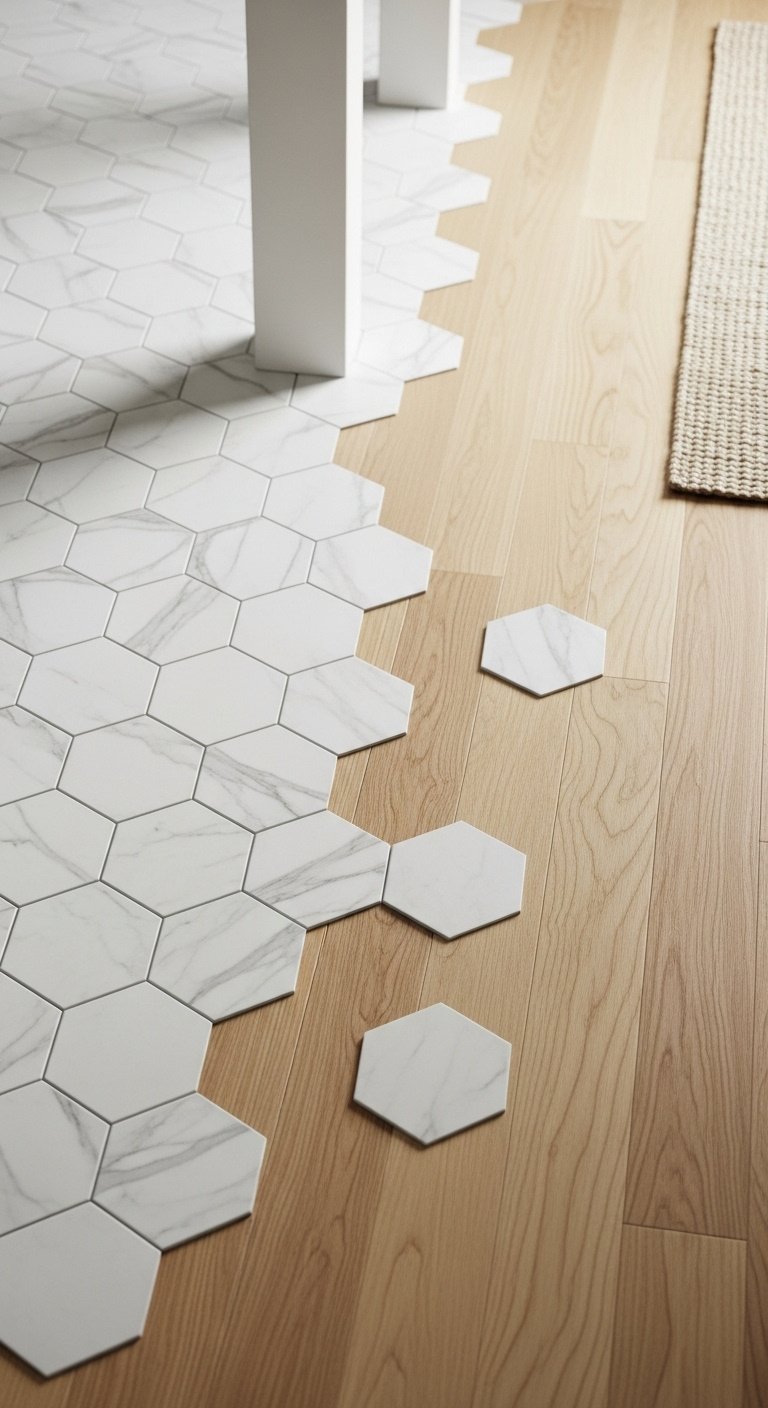
Pin this high-impact design for your dream open-concept living space!
This stunning technique involves cutting hardwood planks to fit perfectly around hexagonal tiles, creating an organic, flowing transition that dissolves the line between rooms. It’s a high-impact design statement perfect for open floor plans.
- Materials Needed: Hexagonal tiles, hardwood flooring, tile adhesive, grout, oscillating multi-tool with wood-cutting blade, jigsaw, paper for template, pencil, wood filler.
- Step-by-Step Directions:
- Lay out your hexagonal tiles in the desired random, flowing pattern at the edge of the kitchen area.
- Create a paper template of the tile edge. Trace the outline of the hexagons where the wood will meet them.
- Place the template onto the hardwood plank that will meet the tile and trace the pattern.
- Carefully cut the hardwood planks using an oscillating tool or jigsaw. This requires precision and patience.
- Install the cut hardwood planks, fitting them snugly against the tiles. Fill any tiny gaps with color-matched wood filler for a seamless look.
> Lesson Learned: This is an advanced technique. For a perfect result, it’s highly recommended to hire a professional flooring installer with experience in custom inlay work. If DIYing, practice on scrap pieces of wood first.
3. The Soft & Elegant: Curved Transition
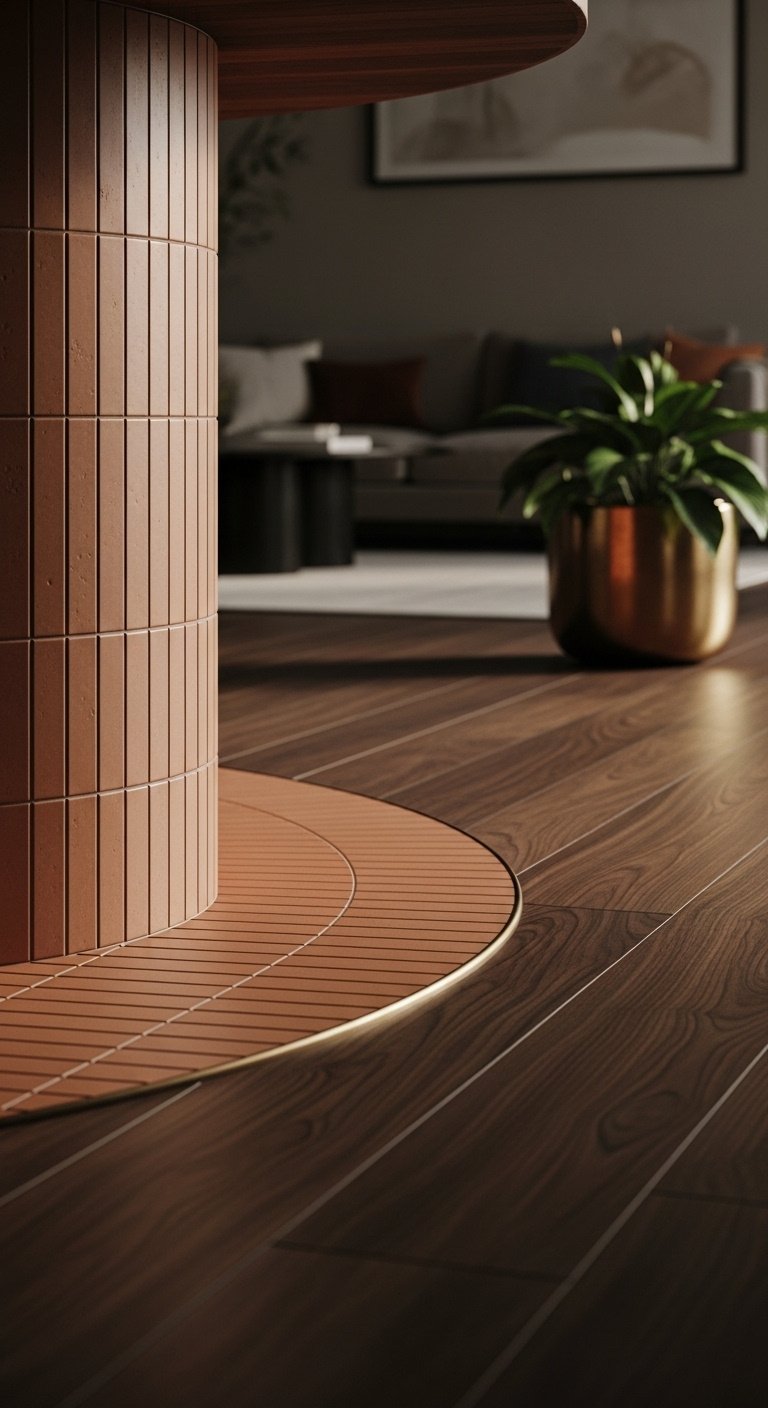
Love this graceful look? Save it to your ‘Home Design Inspo’ board!
A curved transition creates a soft, sweeping line between flooring types, often following an architectural feature like a rounded kitchen island. This approach breaks up the rigid lines of a home, adding a touch of elegance and custom design.
- Materials Needed: Flexible transition molding, or materials for scribing (as in #2), tile wet saw, jigsaw, construction adhesive.
- Step-by-Step Directions:
- Define your curve. This often follows a kitchen island or a desired visual path. Use a large compass or flexible ruler to draw a clean arc on the subfloor.
- For tile, use a wet saw to carefully cut the tiles along the marked curve.
- For wood, use a jigsaw to cut the ends of the planks to match the curve.
- Install both flooring types up to the line, leaving a small gap.
- Bridge the gap using a flexible transition strip designed for curves, or by scribing one material to meet the other for a seamless, no-strip look.
> Pro-Tip: To create a perfect large-scale curve, drive a nail at the center point of your desired arc, tie a string to it with a pencil at the other end, and use it like a giant compass to draw a flawless line on the subfloor.
4. The Artistic Touch: Mosaic Border Transition
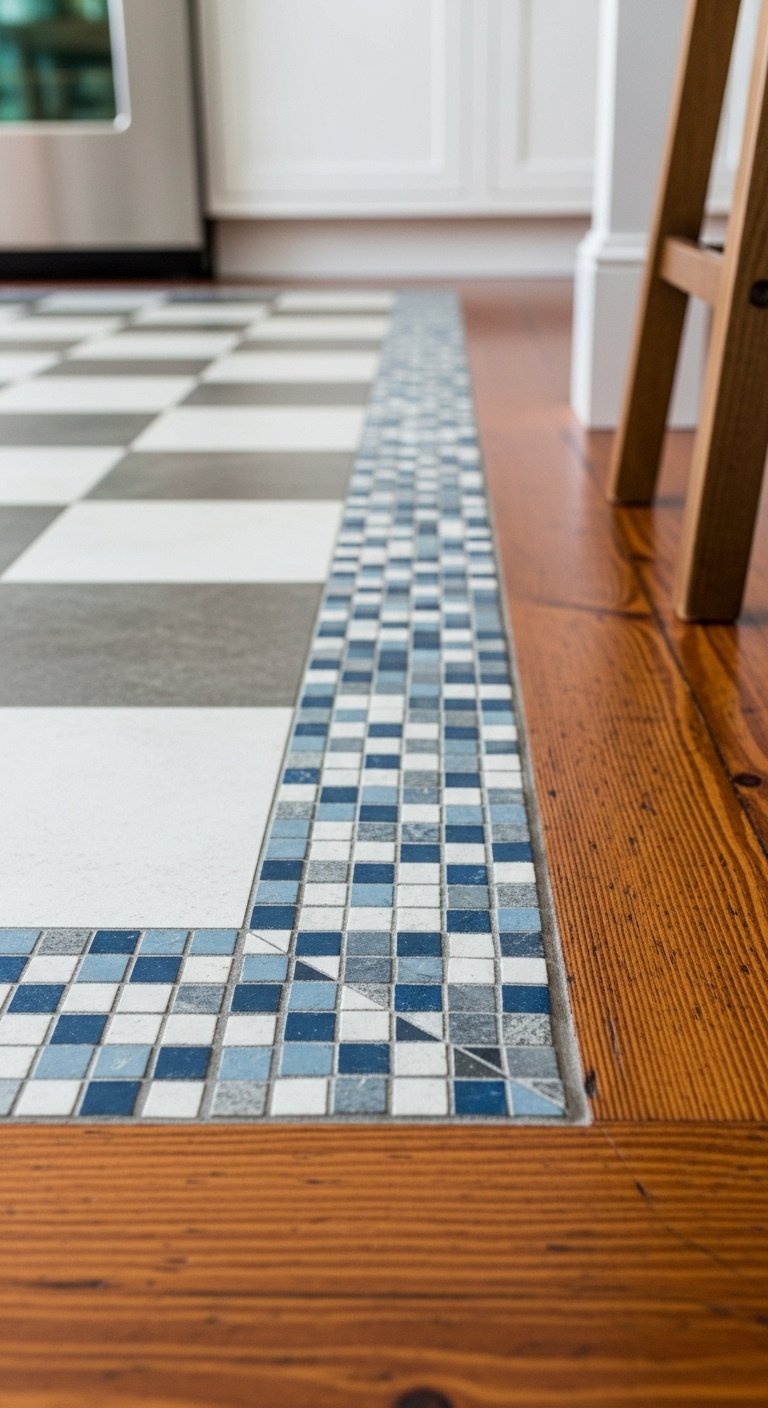
Add a splash of personality! Pin this creative mosaic idea now.
This method involves installing a decorative mosaic tile border in the space between the kitchen tile and the hardwood floor. It turns the transition from a simple line into a deliberate, artistic statement that can tie the whole room together.
- Materials Needed: Mosaic tile sheets, tile adhesive, grout, notched trowel, grout float, sponge.
- Step-by-Step Directions:
- Install the main kitchen tile and the hardwood floor, leaving a planned, straight gap between them for the border (e.g., 6 inches wide).
- Dry-fit the mosaic tile sheets in the gap to ensure a good fit. Cut sheets as needed with a utility knife (cutting the mesh backing).
- Apply a thin layer of tile adhesive in the gap using a notched trowel.
- Press the mosaic sheets firmly into the adhesive. Use a grout float to gently tap them down to be level with the adjacent floors.
- Allow the adhesive to cure, then apply grout over the mosaic, pressing it into the joints. Wipe away excess with a damp sponge.
> Pro-Tip: Choose a mosaic that incorporates colors from both the kitchen tile and the hardwood. This will make the border look intentional and help tie the two spaces together visually.
5. The Bold Statement: Zigzag or Chevron Transition
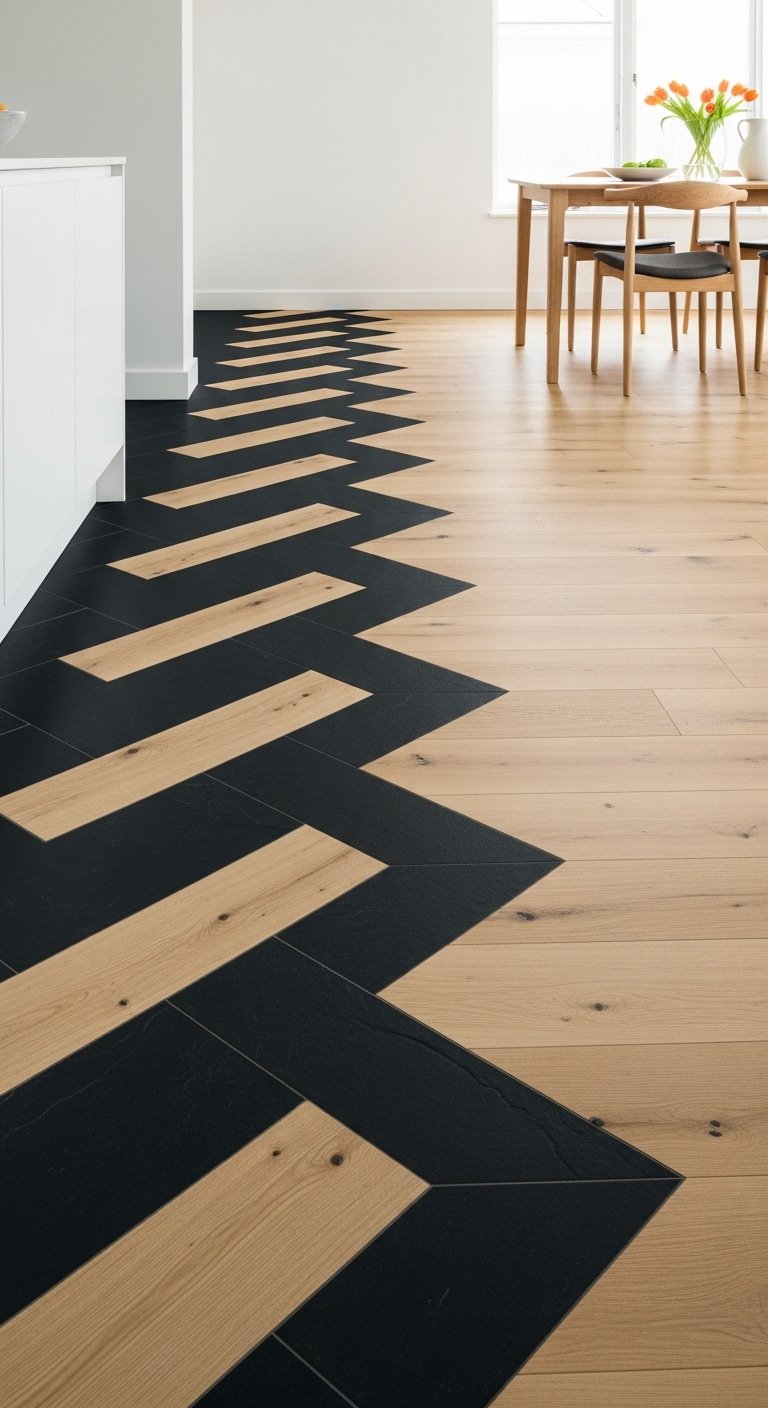
Feeling bold? Save this high-energy design to your ‘Dream Home’ board!
This high-impact design creates a dynamic, interlocking pattern where tile and wood meet at sharp angles. It’s a modern and energetic choice that turns the floor into a graphic work of art, especially effective with high-contrast materials.
- Materials Needed: Tile, hardwood, tile wet saw with miter gauge, miter saw for wood, pencil, large square/straightedge.
- Step-by-Step Directions:
- Plan your zigzag pattern on the subfloor with a pencil and straightedge. Ensure the angles are consistent (e.g., 45 degrees).
- Set the miter gauge on your wet saw to the desired angle and cut the tiles to form the points of the zigzag.
- Set your miter saw to the same angle to cut the ends of the hardwood planks so they fit perfectly into the “V” shapes of the tile pattern.
- This is a precision-heavy installation. Install one side first, then carefully piece the other side in to meet it.
> Lesson Learned: The success of this design is all in the math. Measure twice (or three times!) and cut once. A single bad angle can throw off the entire pattern. This is another design where a professional’s skill is invaluable.
6. The Mixed-Material Inlay: Brass or Steel Accent
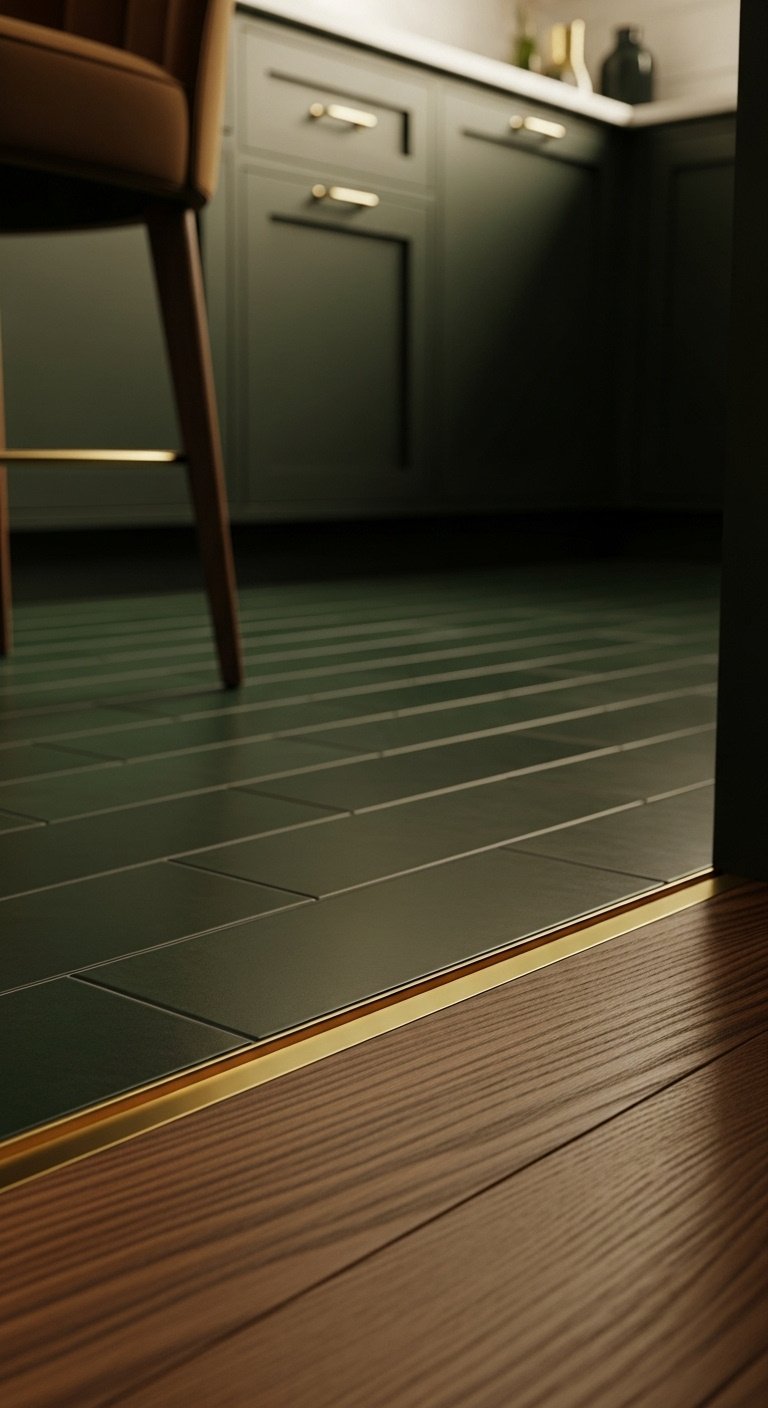
Add a touch of luxury! Pin this brass inlay idea for an elevated look.
A thin metal inlay strip provides a sleek, modern, and luxurious accent between tile and hardwood. Brands like Schluter offer profiles in various finishes like brass, stainless steel, and nickel that create a clean, high-end dividing line.
- Materials Needed: Metal edging/inlay strip (like Schluter-DECO), tile adhesive, tipssaw with a fine-tooth blade.
- Step-by-Step Directions:
- Install the hardwood flooring first, ensuring a clean, straight edge.
- Cut the metal strip to length with a tipssaw.
- Apply tile adhesive along the edge of the hardwood.
- Press the anchoring leg of the metal strip firmly into the adhesive, so the decorative top edge is flush against the hardwood.
- Install your kitchen tiles, setting them into the adhesive and pushing them up against the metal strip for a tight, clean joint. Grout as usual.
> Pro-Tip: Coordinate your metal inlay with other metals in the kitchen, like cabinet hardware or lighting fixtures, for a cohesive and professionally designed feel.
7. The Height Corrector: Hardwood End Cap or Reducer
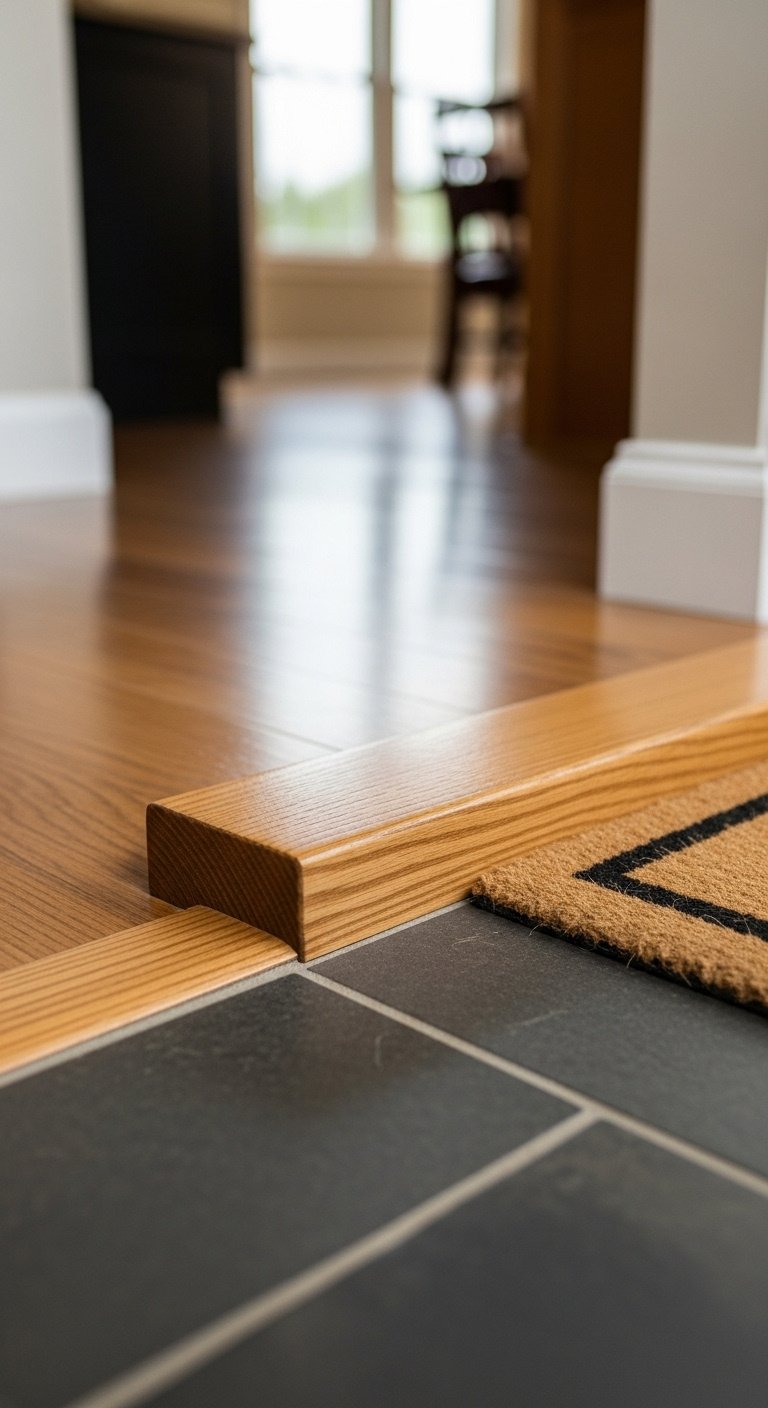
Have uneven floors? Pin this practical and stylish solution!
This is the essential solution for safety when connecting two floors that are not at the same height. A reducer strip is a piece of molding that creates a small, smooth ramp from the higher floor down to the lower one, preventing a trip hazard.
- Materials Needed: Hardwood reducer or end cap molding, measuring tape, miter saw, construction adhesive, finishing nails and nail gun (optional).
- Step-by-Step Directions:
- Identify which type of molding you need. A “reducer” tapers down from a higher floor to a lower one. An “end cap” or “threshold” creates a squared-off finish for one floor before the next begins.
- Measure the width of the doorway or transition area.
- Cut the molding to length with a miter saw.
- Apply construction adhesive to the subfloor where the molding will sit.
- Press the molding firmly into place. For extra security, you can use a nail gun to drive a few finishing nails through the molding into the subfloor.
> Pro-Tip: When choosing a reducer, ensure the height difference it’s designed for matches your floors. They come in various sizes to accommodate different scenarios. Taking a photo and measurements to the store is always a good idea.
8. The Optical Illusion: Grout Line Continuation
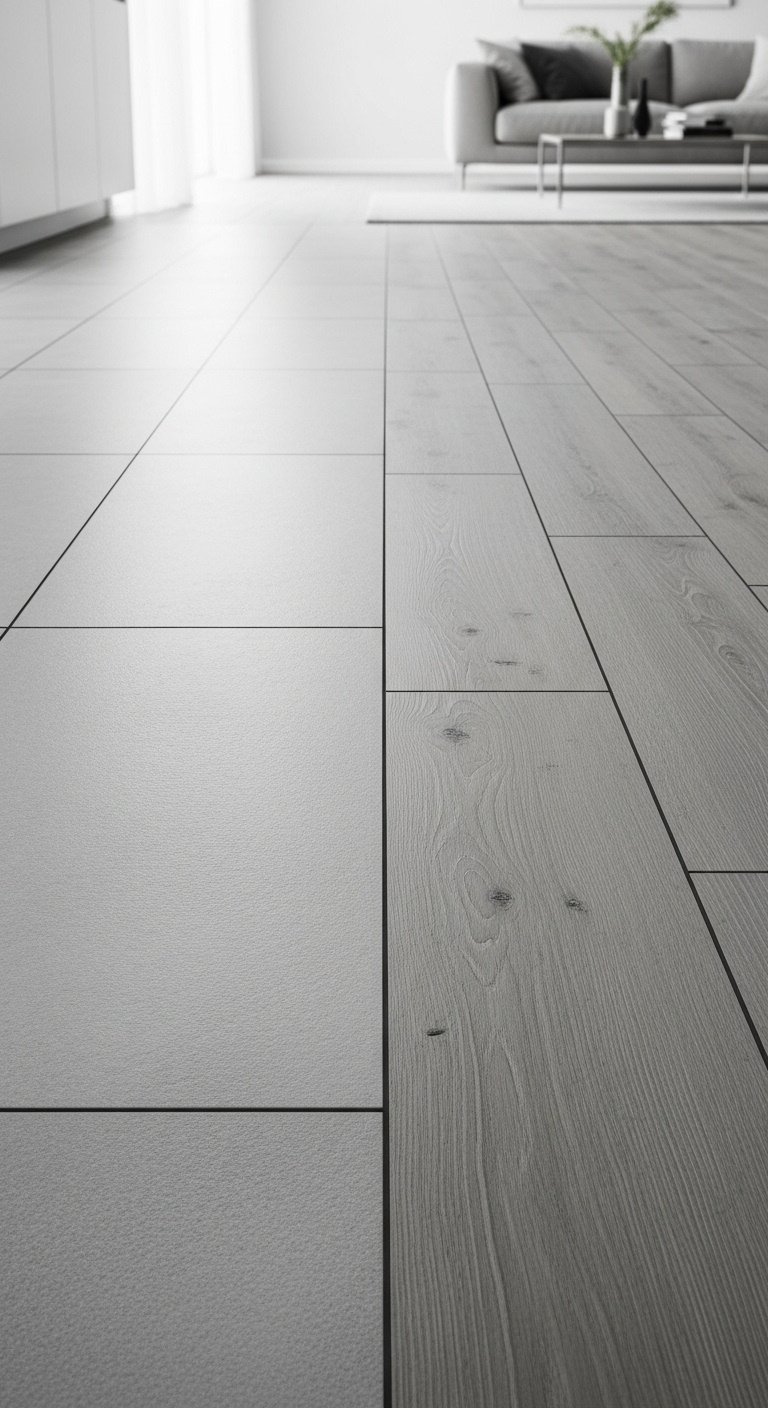
Love this clever trick? Save it to your ‘Modern Design’ board!
This clever technique involves meticulously aligning the grout lines of your tile with the seams of your hardwood planks. By using tiles that are the same width as the wood planks, you can trick the eye into seeing one continuous, seamless surface, which is ideal for minimalist, modern homes.
- Materials Needed: Rectangular tiles, hardwood planks of a similar width, chosen grout, standard flooring installation tools.
- Step-by-Step Directions:
- This technique requires meticulous planning before installation begins. Choose a tile that is the same width as your hardwood planks.
- Start by laying the hardwood flooring.
- When you begin laying the tile, start at the transition line. Align the edge of the first tile perfectly with the edge of the first hardwood plank.
- Use tile spacers that create a grout line of the same width as the natural seam between hardwood planks.
- Continue the layout, ensuring every grout line is a perfect continuation of a hardwood seam.
> Lesson Learned: This only works if the hardwood planks and the tiles are very close in width. This method demands extreme precision from the very first piece laid down. Any deviation will become more noticeable across the floor.
9. The Natural Blend: Gradual “Faded” Transition
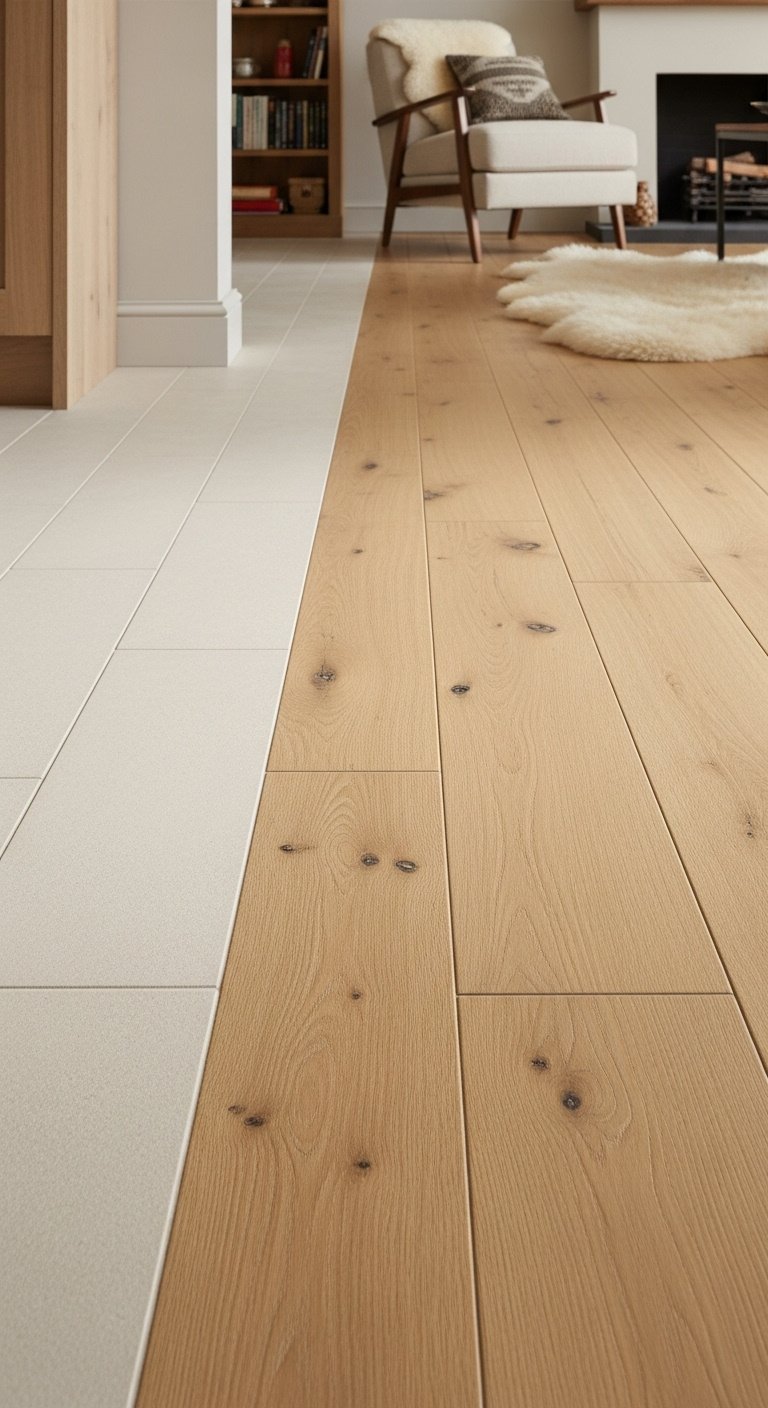
Love this subtle and unique blend? Pin it for your open-concept home!
A truly custom look, this transition involves interspersing tiles and wood planks in a “fade zone” to create a gradual, organic blend. By choosing tile and wood with very similar color tones, you can achieve a soft, seamless flow with no hard lines.
- Materials Needed: Tile and hardwood with very similar color tones, standard installation tools for both.
- Step-by-Step Directions:
- Plan the “fade zone” on paper first. Decide how many full rows of tile you want, then plan how you will randomly but aesthetically swap out some tiles for wood planks.
- Install the main tile floor up to the fade zone.
- In the next row, replace one or two tiles with hardwood planks cut to the same length.
- In the following row, use more hardwood planks than tiles.
- Continue until the final row is all hardwood. This requires cutting both tile and wood to fit together like a puzzle.
> Pro-Tip: The key to this look is color harmony. The tile and wood don’t have to be identical, but they should share the same undertone (e.g., warm terracotta with warm oak, or cool grey tile with cool-toned maple) to look cohesive.
10. The Perpendicular Pop: 90-Degree Angle Transition
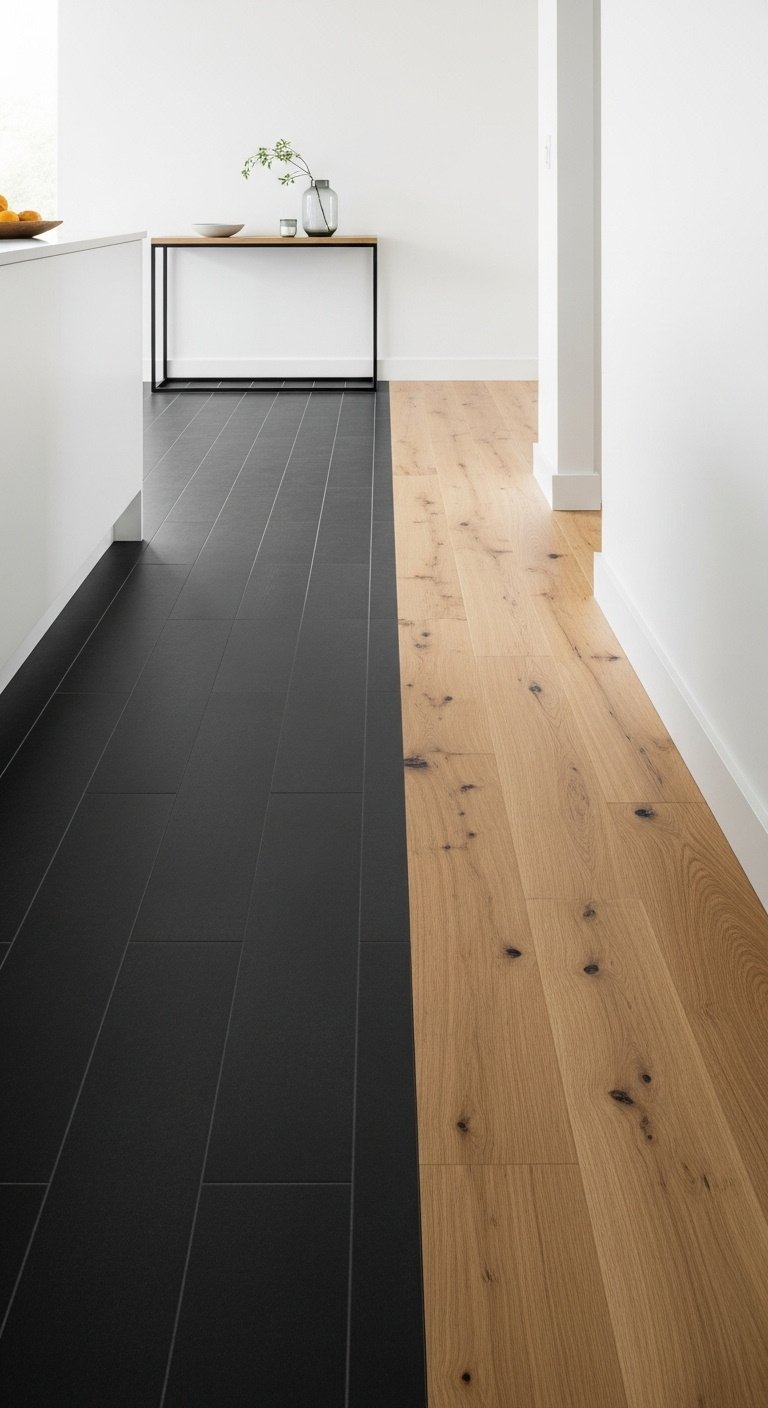
A simple but bold idea! Pin this for an easy and effective transition.
This simple yet effective method uses the direction of the flooring itself to create a strong, deliberate border. By running the kitchen tile in one direction and the hardwood planks at a 90-degree angle, you create a clear and intentional separation between the two spaces without needing a complex pattern.
- Materials Needed: Your chosen tile and hardwood, transition strip (optional).
- Step-by-Step Directions:
- Decide which direction your tile and wood will run. Typically, wood runs the length of the longest wall. The tile can run perpendicular to this.
- For the cleanest look, install a “header board” – a single plank of the hardwood running perpendicular to the rest of the wood, right along the transition line.
- Install the rest of the hardwood planks, butting them up against the long side of the header board.
- Install the tile on the other side, running it up to the header board or a transition strip.
> Pro-Tip: Using a header board creates a very clean, finished frame for the kitchen tile area and makes the change in direction look like a deliberate design choice rather than an accident.
11. The Zoned Space: Tile Inlay or “Rug” Effect
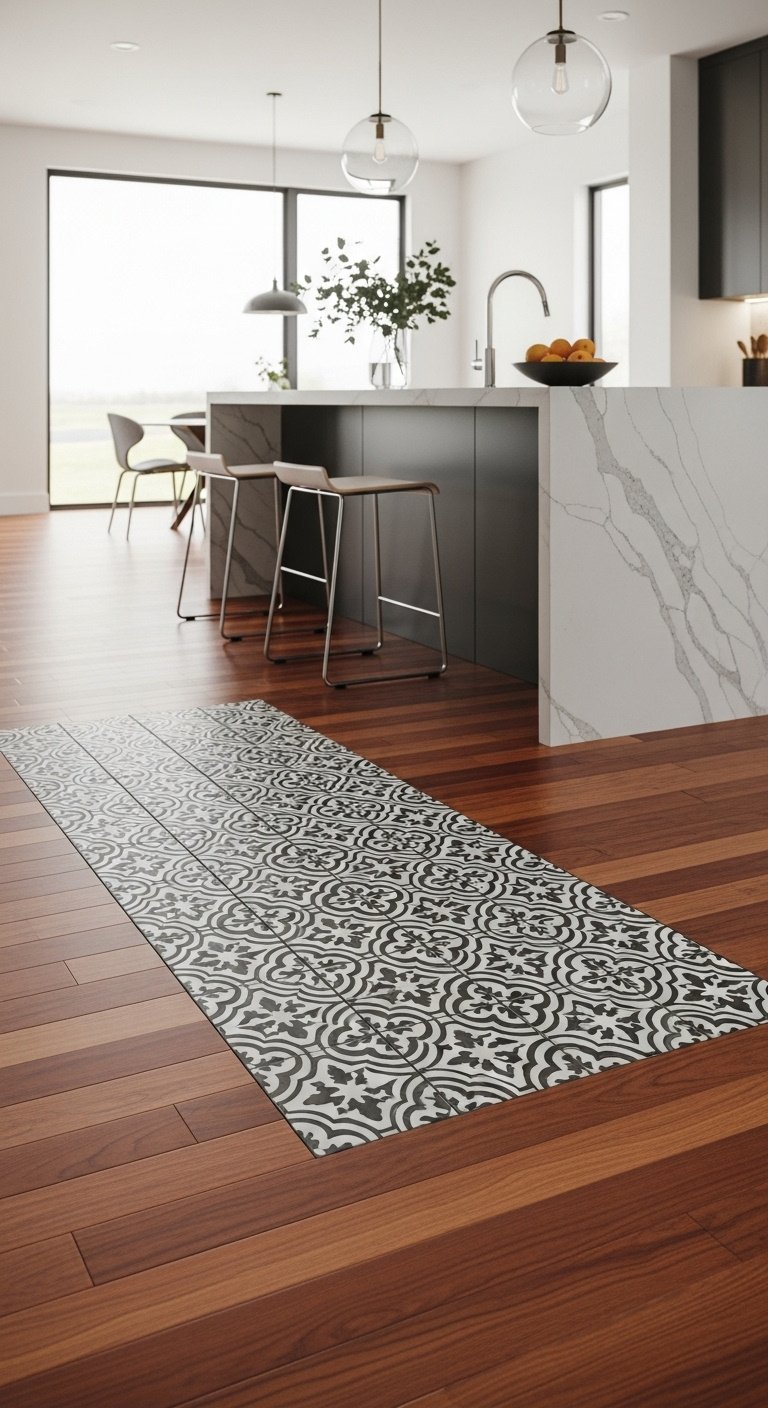
Define your kitchen space in style. Pin this tile rug idea!
This high-end technique involves inlaying a section of tile within a larger field of hardwood, creating a “tile rug” effect. This is a brilliant way to visually define a specific functional area, like the kitchen workspace, within a large, open-concept room.
- Materials Needed: Hardwood flooring, patterned tile, plywood for subfloor adjustment, tile adhesive, grout.
- Step-by-Step Directions:
- Frame out the inlay area on the subfloor. Install the hardwood flooring around this designated rectangle.
- Check the thickness of your tile versus your hardwood. Often, you will need to add a layer of plywood inside the frame to raise the subfloor so the finished tile will be perfectly level with the hardwood.
- Install the tiles within the framed-out area as you would on any floor.
- Grout the tiles. The surrounding hardwood acts as a natural, beautiful frame.
> Lesson Learned: The most critical step here is ensuring the final height of the tile and the hardwood are identical. Carefully measure the thickness of your hardwood, your tile, and the layer of thin-set mortar to calculate the exact height your subfloor needs to be.
Key Takeaways: Your Quick Guide to Flawless Floor Transitions
- Prioritize Level Floors: The most critical factor for safety and aesthetics is ensuring both flooring surfaces are the same height. If not, use a dedicated reducer strip.
- Harmony is Key: Coordinate colors and textures. Match warm-toned tiles with warm-toned woods. The goal is a cohesive look, not a jarring clash.
- Choose Your Style: Decide if you want a seamless, blended transition (like the Hexagon Flow) or a distinct, defined border (like a Metal Inlay or Mosaic).
- Plan Before You Install: The best transitions are planned from the beginning, not figured out at the end. Measure carefully and know your materials.
- When in Doubt, Hire a Pro: Complex transitions like curves, zigzags, or inlays require a high level of skill. Investing in a professional installer can save you from a costly DIY mistake.
People Also Ask About Kitchen Tile and Hardwood Floors
What tile looks good next to hardwood floors?
Tiles with natural tones that complement the wood’s undertones work best. For warm oak or cherry hardwood, consider terracotta, beige travertine, or cream-colored tiles. For cool-toned or grey-washed wood, slate, marble-look porcelain, or concrete-style tiles create a harmonious look. The key is to match the temperature (warm vs. cool) of the materials.
How do you transition between tile and hardwood floors?
The most common method is using a T-molding strip, which covers the expansion gap between two floors of the same height. For uneven heights, a reducer strip creates a smooth ramp. For a more integrated look, you can create a custom transition by cutting wood to fit against shaped tiles (like hexagons) or by installing a decorative mosaic border between the two floors.
Can you mix tile and hardwood floors in an open floor plan?
Absolutely. Mixing tile and hardwood is a great way to define functional zones in an open floor plan. Use tile in the kitchen area for durability and water resistance, and hardwood in the living/dining areas for warmth. A well-planned transition, like a gentle curve or an integrated pattern, is essential to make the combination look intentional and high-end.
How do you transition from wood to tile with different heights?
The safest and most common solution is to use a transition strip called a “reducer.” This piece of molding is higher on one side to meet the wood floor and tapers down to meet the lower tile floor, creating a small, smooth ramp. This prevents a dangerous trip hazard and gives the transition a clean, finished appearance.
Final Thoughts
The transition between your kitchen tile and hardwood floor isn’t just a problem to be solved; it’s a genuine opportunity to add a unique, custom design element to your home. By planning ahead and choosing a style that complements your overall aesthetic, you can create a flawless connection that is safe, durable, and beautiful.
Which of these transition ideas is your favorite for your own home? Let us know in the comments below
